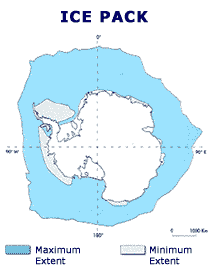|
|
|
|
An immense ice floe Frightening, gigantic, mysterious, the Antarctic ice floes, which are also known as pack ice, are created in winter and almost totally disappear in summer; 20 million square kilometres of ice in September (there is a lower estimate of this figure - 15 million - if the areas of open water like the channels and polynyas are discounted) and four million square kilometres (3 million) six months later.
When the weeks of the intense cold arrive and the conditions are at their best for glaciation, the front of the ice floe can advance by 4 kilometres a day, increase by about 100,000 square kilometres in twenty-four hours and stretch up to 3,000 kilometres from the Antarctic coasts, thereby going beyond the austral polar circle. This gigantism stems from the fact that, unlike the Arctic ice which is hemmed in by emerged lands, the Antarctic pack ice is unrestricted in its movement; this autonomy has given rise to the slow and enigmatic movement of the ice, better known as the drift of the floe. One could recall here the wintering of the Belgian ship the Belgica, which was the first to spend the winter in southern waters. Between the beginning of the month of March 1898 and 14 March 1989 (the day when they were freed), despite its total immobility in a vice of ice, the Belgian three-master had covered, solely from the effect of the drift, a trifling 1,700 nautical miles and emerged from the pack ice 335 miles to the Northwest of the position observed the day when the grip of the ice had surprised them! Observations of the drift of the floe continued after the drift of the Belgica, whether thanks to other vessels, to scientific ships or by following probes deposited on the ice. Recently, some American and Russian scientists were deposited on a part of the ice floe in the Weddell Sea on which they drifted for several months, providing particularly interesting data. All these efforts have led to a better understanding of the causes of the movement of the ice. The main force driving the ice seems to be the wind. An approximate rule provides for a speed of the ice of the order of 2% of the speed of the wind when the ice cover is not too dense - that is to say 0.5mph for a wind of 25mph. There then follows the effect of the ocean, the Coriolis Effect that tends to deviate the ice towards the left in Antarctica, and the internal forces of the ice that can crush a ship, as was notably the case with the wreck of Endurance, the schooner of the English explorer, Shackleton. Everything concerning the Antarctic ice floe is endowed with considerable importance when one considers global climatology. 15 or 20 million square kilometres of sea are not, in effect, transformed into ice each year without the seasonal blanket of air profoundly altering the habitual exchanges that take place between ocean and atmosphere, and which have a precise influence on climate: gas levels (CO2 in particular), heat transfers (everybody knows that ice is an effective insulator) and reflection of the solar rays.
|

